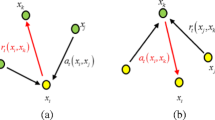Abstract
As a novel clustering method, affinity propagation (AP) clustering can identify high-quality cluster centers by passing messages between data points. But its ultimate cluster number is affected by a user-defined parameter called self-confidence. When aiming at a given number of clusters due to prior knowledge, AP has to be launched many times until an appropriate setting of self-confidence is found. K-AP algorithm overcomes this disadvantage by introducing a constraint in the process of message passing to exploit the immediate results of K clusters. The key to K-AP clustering is constructing a suitable similarity matrix, which can truly reflect the intrinsic structure of the dataset. In this paper, a density-adaptive similarity measure is designed to describe the relations between data points more reasonably. Meanwhile, in order to solve the difficulties faced by K-AP algorithm in high-dimensional data sets, we use the dimension reduction method based on spectral graph theory to map the original data points to a low-dimensional eigenspace and propose a density-adaptive AP clustering algorithm based on spectral dimension reduction. Experiments show that the proposed algorithm can effectively deal with the clustering problem of datasets with complex structure and multiple scales, avoiding the singularity problem caused by the high-dimensional eigenvectors. Its clustering performance is better than AP clustering algorithm and K-AP algorithm.





Similar content being viewed by others
Explore related subjects
Discover the latest articles, news and stories from top researchers in related subjects.References
Jigui Sun, Jie Liu, Lianyu Zhao (2008) Clustering algorithms research. J Softw 19(1):48–61
Frey BJ, Dueck D (2007) Clustering by passing messages between data points. Science 315(5814):972–976
Zhang XL, Wang W, Nørvag K et al (2010) K-AP: generating specified K clusters by efficient affinity propagation. In: Proceedings 2010 10th IEEE international conference on data mining (ICDM 2010), pp 1187–1192
Nascimento MCV, de Carvalho ACPLF (2011) Spectral methods for graph clustering-A survey. Eur J Oper Res 211(2):221–231
Lu HT, Fu ZY, Shu X (2014) Non-negative and sparse spectral clustering. Pattern Recogn 47(1):418–426
Ding SF, Qi BJ, Jia HJ et al (2013) Research of semi-supervised spectral clustering based on constraints expansion. Neural Comput Appl 22(Suppl 1):405–410
Jun Dong, Suoping Wang, Fanlun Xiong (2010) Affinity propagation clustering based on variable-similarity measure. J Electron Inf Technol 32(3):509–514
Jiang XP, Hu XH, Xu WW et al (2013) Comparison of dimensional reduction methods for detecting and visualizing novel patterns in human and marine microbiome. IEEE Trans Nanobiosci 12(3):199–205
Huang CC, Tu SH, Lien HH et al (2014) Estrogen receptor status prediction by gene component regression: a comparative study. Int J Data Min Bioinform 9(2):149–171
Sun WW, Halevy A, Benedetto JJ et al (2014) Nonlinear dimensionality reduction via the ENH-LTSA method for hyperspectral image classification. IEEE J Sel Top Appl Earth Obs Remote Sens 7(2):375–388
Fan MY, Zhang XQ, Lin ZC et al (2014) A regularized approach for geodesic-based semisupervised multimanifold learning. IEEE Trans Image Process 23(5):2133–2147
Dhanjal C, Gaudel R, Clemencon S (2014) Efficient eigen-updating for spectral graph clustering. Neurocomputing 131:440–452
Ding SF, Jia HJ, Zhang LW et al (2014) Research of semi-supervised spectral clustering algorithm based on pairwise constraints. Neural Comput Appl 24(1):211–219
Wacquet G, Caillault EP, Hamad D et al (2013) Constrained spectral embedding for K-way data clustering. Pattern Recogn Lett 34(9):1009–1017
Ng AY, Jordan MI, Weiss Y (2002) On spectral clustering: analysis and an algorithm. Adv Neural Inf Process Syst 14:849–856
Zhou D, Bousquet O, Lal TN, Weston J (2004) Learning with local and global consistency. Adv Neural Inf Process Syst 16:321–328
Wang Y, Jiang Y, Wu Y, Zhou ZH (2011) Spectral clustering on multiple manifolds. IEEE Trans Neural Networks 22(7):1149–1161
Golub TR, Slonim DK, Tamayo P et al (1999) Molecular classification of cancer: class discovery and class prediction by gene expression monitoring. Science 286(5439):531–537
Perou CM, Sørlie T, Eisen MB et al (2000) Molecular portraits of human breast tumours. Nature 406:747–752
Alizadeh AA, Eisen MB, Davis RE et al (2000) Distinct types of diffuse large B-cell lymphoma identified by gene expression profiling. Nature 403:503–511
Bach F, Jordan M (2003) Learning spectral clustering. In: Proceedings of neural information processing systems (NIPS 2003), pp 305–312
Xie JY, Jiang S, Xie WX et al (2011) An efficient global K-means clustering algorithm. J Comput 6(2):271–279
Acknowledgments
This work is supported by the National Natural Science Foundation of China (No. 61379101) and the National Key Basic Research Program of China (No. 2013CB329502).
Author information
Authors and Affiliations
Corresponding author
Rights and permissions
About this article
Cite this article
Jia, H., Ding, S., Meng, L. et al. A density-adaptive affinity propagation clustering algorithm based on spectral dimension reduction. Neural Comput & Applic 25, 1557–1567 (2014). https://doi.org/10.1007/s00521-014-1628-7
Received:
Accepted:
Published:
Issue Date:
DOI: https://doi.org/10.1007/s00521-014-1628-7




